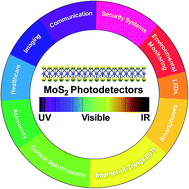A review of molybdenum disulfide (MoS2) based photodetectors: from ultra-broadband, self-powered to flexible devices
Abstract
Two-dimensional transition metal dichalcogenides (2D TMDs) have attracted much attention in the field of optoelectronics due to their tunable bandgaps, strong interaction with light and tremendous capability for developing diverse van der Waals heterostructures (vdWHs) with other materials. Molybdenum disulfide (MoS2) atomic layers which exhibit high carrier mobility and optical transparency are very suitable for developing ultra-broadband photodetectors to be used from surveillance and healthcare to optical communication. This review provides a brief introduction to TMD-based photodetectors, exclusively focused on MoS2-based photodetectors. The current research advances show that the photoresponse of atomic layered MoS2 can be significantly improved by boosting its charge carrier mobility and incident light absorption via forming MoS2 based plasmonic nanostructures, halide perovskites–MoS2 heterostructures, 2D–0D MoS2/quantum dots (QDs) and 2D–2D MoS2 hybrid vdWHs, chemical doping, and surface functionalization of MoS2 atomic layers. By utilizing these different integration strategies, MoS2 hybrid heterostructure-based photodetectors exhibited remarkably high photoresponsivity raging from mA W−1 up to 1010 A W−1, detectivity from 107 to 1015 Jones and a photoresponse time from seconds (s) to nanoseconds (10−9 s), varying by several orders of magnitude from deep-ultraviolet (DUV) to the long-wavelength infrared (LWIR) region. The flexible photodetectors developed from MoS2-based hybrid heterostructures with graphene, carbon nanotubes (CNTs), TMDs, and ZnO are also discussed. In addition, strain-induced and self-powered MoS2 based photodetectors have also been summarized. The factors affecting the figure of merit of a very wide range of MoS2-based photodetectors have been analyzed in terms of their photoresponsivity, detectivity, response speed, and quantum efficiency along with their measurement wavelengths and incident laser power densities. Conclusions and the future direction are also outlined on the development of MoS2 and other 2D TMD-based photodetectors.

- This article is part of the themed collection: 2020 Reviews in RSC Advances


 Please wait while we load your content...
Please wait while we load your content...